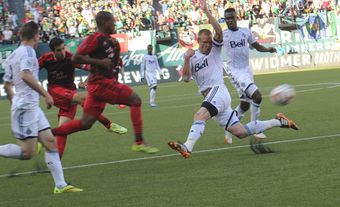Soaring
Soaring, or gliding, is the sport of flying a sailplane or glider for a sustained period of time by utilizing currents of rising air to stay aloft. The term "soaring" means ascending, high flying or mounting upward, while "gliding" describes the more basic flying which is performed during take-off, circuit patterns and landings. Some sailplanes are motorized and self-launching, but the majority are launched by aero-tow, winch or car-tow from about 50 airfields across the country. Instruction in the art and science of soaring is given freely by volunteer instructors qualified to national standards and operating within a club structure. As a rule, students pay for club membership and for the use of aircraft; once licensed, pilots can opt for private ownership.
Glider design and development has often been at the forefront of aviation technology. The first powered aircraft were developed by the Wright brothers in the US and J.A.D. MCCURDY and others in Canada from gliders. For example, some remarkable gliders were designed, built and briefly flown in Europe during the second half of the 19th century. In 1902 the general problem of lack of control in flight was solved when the first glider with 3-axis flight control (pilot control in pitch, yaw and roll) was built in the US by the Wright brothers; only after achieving equilibrium in the air could they safely add an engine and develop the first successful powered aircraft. While sleek aircraft profiles may seem to be a recent innovation, soaring pilots have long known that only smooth well-profiled wings could ensure the efficiency and higher speeds needed to win sailplane races. This has meant that fibreglass, carbon fibres and other space-age composites have been used in the construction of sailplanes decades before their acceptance by commercial aviation companies. The first all fibreglass sailplane to be built in Canada was designed as long ago as 1960. In addition to promoting the practical use of advanced materials, the unique ability of the glider pilot to fly at low speeds has helped in the first hand analysis of flutter and structural instability, while an intimate understanding of air currents - particularly in thunderstorms and around and over mountain ranges - continues to enrich our knowledge of meteorology.
The first gliders in Canada were built by adventurous individuals early in the 20th century. Most were copied from magazine diagrams and were more akin to kites and hang gliders. As gliding became popular in Germany and the US in the 1920s, the idea of "airmindedness" spread to Canada and by 1930, Halifax, New Glasgow, Montréal, Ottawa, Toronto, Windsor, North Battleford, Lethbridge, Calgary and Vancouver all had gliding clubs. By the mid-1930s, successful clubs had sprung up all over the Prairies where the terrain was ideal, and where dust-bowl conditions and the Depression had given a lot of young people free time to get involved in an affordable do-it-yourself type of flying. At that time, little was known about thermal updrafts and the sport consisted of being towed up to 30 m or less (by horse, car, winch and occasionally aeroplane) and gliding down to the take-off point with a turn or 2 if there was enough height. The first planned distance flight in which the pilot landed 10 miles from home after climbing to a height of 1200 m was done by a Lethbridge woman, Evelyn Fletcher, in 1939.
In the 1940s, a new breed of pilots emerged from the armed forces and saw the need to organize the gliding movement so that safety, instruction and competition could be encouraged and standardized, and lines of communication opened across the country; the Soaring Association of Canada (SAC) was incorporated in 1945 and the first issue of the national magazine Free Flight was printed in 1949. In 1947 Ovila "Shorty" Boudreault of Ottawa earned an international soaring badge, and Canadian pilots began to measure their standards against those of the rest of the world. In 1949, Canada held its first national contest. However, by 1952 a Canadian team was ready to compete internationally in Spain and since that time has been represented at most World Soaring Contests sponsored by the Fédération Aeronautique Internationale (FAI). Several Canadians have had daily placings in the top 10, but the best result was by Wolf Mix of Toronto, who in 1970 came fourth overall in the standard class.
Pins are awarded for reaching several international levels of soaring proficiency from the basic 5 hours duration, and 1000 m altitude gain to completing a 1000 km triangle. Records are maintained at national and world levels for distance, altitude and speed around courses of set length. (Duration record attempts were stopped after pilot endurance became the limiting safety factor over pilot skill.) Some of the Canadian records recognized by the FAI are 126.3 km/h around a 500 km out and return, Kevin Bennett; 108.8 km/h around a 750 km triangle, W. Krug, 1982; 1093 km straight distance, M. Apps and D. Marsden 1984. The highest altitude attained so far is 10 485 m by B. Hea in 1982. The highest gain of altitude is 8458 m, by Dave Mercer (1995).

 Share on Facebook
Share on Facebook Share on X
Share on X Share by Email
Share by Email Share on Google Classroom
Share on Google Classroom


